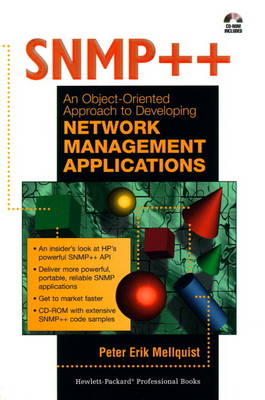
SNMP++
Prentice Hall (Verlag)
978-0-13-264607-9 (ISBN)
- Titel ist leider vergriffen;
keine Neuauflage - Artikel merken
26460-6 Deliver smarter SNMP applications faster, with SNMP++ SNMP++ is Hewlett-Packard's new API for simplifying SNMP applications development using C++ and object-oriented techniques. For network management applications developers, though, SNMP++ is more than an API: it's a breakthrough. In this book, you'll learn how SNMP++ will help you build network management applications that are more portable, powerful, extensible and reliable. And if that's not enough, you'll also discover how SNMP++ can help you get to market faster than ever before. Written by a Hewlett-Packard engineer who helped develop SNMP++, this is the first book to cover the entire SNMP product development lifecycle, from analysis through design and implementation. Step-by-step, you'll learn how to use SNMP++ to build powerful applications with a minimum of coding effort. The book includes practical definitions and examples of every C++ class in the new SNMP++ class library. It shows how SNMP++ classes work together, covers cross-platform issues, extensibility and reuse.Finally, it walks through the construction of a complete network management application for Windows NT and Windows 95 using Microsoft's Visual C++ and the SNMP++ class library.
All source code is provided on CD-ROM. If you're a network management software developer, SNMP++ represents an extraordinary opportunity for competitive advantage-and this book puts you on the inside track.
List of Tables.
List of Figures.
List of Examples.
Preface.
I: AN INTRODUCTION TO NETWORK MANAGEMENT AND SNMP++.
1. Systems and Network Management.
Management of Systems and Networks.
Architecture of Management.
Goals of Management.
Keeping Networks Running. Maintaining Network Performance. Reducing the Cost of Ownership.
Management Standards and Protocols.
Networking Standards Organizations. Standardized Management Protocols.
Areas of Network Management.
Fault Management. Accounting Management. Configuration Management. Performance Management. Security Management.
2. Introduction to the Simple Network Management Protocol.
Brief History of SNMP. The SNMP Agent.
Agent SNMP Protocol Engine. Management Information Base. Instrumentation Layer.
The SNMP Manager.
Management Platform. Stand-Alone Management Applications.
SNMP Data Representation.
Protocol Data Units. Variable Bindings. Object Identifiers. Structure of Management Information (SMI) Types.
Protocol Interactions.
Request/Response Interactions. Notifications.
SNMP Version 1. SNMP Version 2.
3. Object-Oriented Programming.
Object Orientation. Problems Addressed by Object Orientation.
Objects and Classes. Abstraction. Encapsulation. Inheritance. Polymorphism.
Why Object Orientation Works. Object-Oriented Analysis and Design.
Object Modeling Technique (OMT). OMT Object Model. OMT Dynamic Model. OMT Functional Model.
C++.
A Better C. Data Abstraction and Encapsulation. Operator Overloading.
4. Introduction to SNMP++.
History of SNMP++.
WinSNMP++. Hewlett-Packard SNMP++. SNMP++ Open Specification.
Motivation.
Too Many APIs. Lack of Object Orientation. Lack of Simplicity. Too Expensive to Develop Multiplatform Applications. There Has to Be a Better Way!
Objectives of SNMP++.
Ease of Use and SNMP++. Programming Safety and SNMP++. Portability and SNMP++. Extensibility and SNMP++.
SNMP++ Features.
Full Set of C++ Based SNMP Classes. Automatic SNMP Memory Management. Ease of Use. Power and Flexibility. Portable Objects. Automatic Time-Out and Retries. Blocked Mode Requests. Non-Blocking Asynchronous Mode Requests. Notifications, Trap Reception, and Sending. Support for SNMP Versions 1 and 2 Through a Bilingual API. SNMP Get, Get-Next, Get-Bulk, Set, Inform, and Trap Supported. Redefinition Through Inheritance.
A Simple SNMP++ Example.
Explanation of Introductory Example.
II: THE SNMP++ FRAMEWORK.
5. The Operational Model.
The SNMP++ Framework. SNMP Syntax Classes. The Session Model. Working with SNMP Targets.
SNMP Community-Based Targets.
Asynchronous and Blocking Modes of Operation.
6. The SnmpSyntax Classes.
The Object Identifier Class.
Oid Class Examples.
The Octet String Class.
Special Features. OctetStr Class Examples. Working with ASCII and Non-ASCII OctetStr Objects.
The Counter32 Class.
Counter32 Class Examples.
The Counter64 Class. The Gauge32 Class.
Gauge32 Class Examples.
The TimeTicks Class.
Special Features.
The Network Address Classes.
Using the Network Address Classes. Network Address Base Class. Address Classes Constructors. IpAddress Class Special Features. GenAddress Class. Address Class Validation. UdpAddresses and IpxSockAddresses. Valid Address Formats. Address Class Examples.
7. The Variable Binding Class.
Vb Class Public Member Functions.
Vb Class Constructors and Destructors. Vb Class Get Oid/Set Oid Member Functions. Vb Class Get Value/Set Value Member Functions. Vb Class Get Value Member Functions. Vb Object Validation Check. Printing the Oid and Value Portions of a Vb Directly. Vb Object Assignment to Other Vb Objects. Vb Object Errors. Vb Syntax and Exception Values.
8. The Protocol Data Unit and SnmpTarget Classes.
The Pdu Class.
Pdu Class Constructors and Destructors. Pdu Class Access Member Functions. Pdu Class Overloaded Operators. Pdu Class Member Functions for Traps and Informs.
The SnmpTarget Class.
Abstract Targets. Target Addresses. Retransmission Policies. CTarget Class (Community-Based Targets). Constructing CTarget Objects.
9. The Snmp Class.
Bilingual API. Snmp Class Constructors and Destructors.
Snmp Class Constructor. Snmp Class Destructor.
Snmp Class Public Member Functions.
Snmp Class Blocked Get Member Function. Snmp Class Blocked Get-Next Member Function. Snmp Class Blocked Set Member Function. Snmp Class Blocked Get-Bulk Member Function.
Snmp Class Asynchronous Member Functions.
When to Use Blocked Mode vs. When to Use Asynchronous Mode. SNMP++ Asynchronous Callback Function Type Definition. Snmp Class Asynchronous Get Member Function. Snmp Class Asynchronous Get-Next Member Function. Snmp Class Asynchronous Set Member Function. Snmp Class Asynchronous Get-Bulk Member Function. Canceling an Asynchronous Request.
SNMP++ Notification Methods.
Sending Traps. Sending Trap Member Function Parameter Descriptions. Inform Member Functions. Snmp Class Asynchronous Inform Member Function. Snmp Class Blocked Inform Member Function. Receiving Notifications. AddressCollection Element Behavior Definition. Filtering Using OidCollection, TargetCollection, and AddressCollections.
SNMP++ Class Error Return Codes.
Snmp Class Error Message Member Function.
Operational Modes.
Microsoft Windows Event System Operation. Open Systems Foundation (OSF) X11 Motif Operation. Non-GUI-Based Application Operation.
SNMP++ Status and Error Codes. SnmpCollections.
Special Features. Examples of Collections in SNMP++.
III: DEVELOPING NETWORK MANAGEMENT APPLICATIONS.
10. Writing Applications with SNMP++.
SNMP++ for Microsoft Windows 32-Bit Environments.
WinSNMP and SNMP++.
SNMP++ for Hewlett-Packard UNIX (HPUX) Environments. Description of Header Files. Compact Disc (CD-ROM) Contents.
SNMP++ Source Code. SNMP++ Binaries and Header Files. SNMP++ SNMP Browser for Win32. IETF SNMP RFCs. SNMP++ Open Specification Document. WinSNMP. SNMP++ WWW Site.
Required Tools and Environment.
Building the SNMP++ DLL. Building the SNMP++ Browser Application.
11. The SNMP++ Browser Application.
SnmpTarget Manager.
Target Manager User Interface. Target Defaults. Target Factory. Alternate Methods of Defining SnmpTargets.
Performing an SNMP++ Get.
The Get User Interface. Selecting an SnmpTarget. Selecting an MIB Variable to Get. Selecting an Oid from an MIB Tree. Issuing an Asynchronous Get Method. Receiving a Get Response via Callback Function. Displaying the Get Response.
Performing an SNMP++ Set.
The Set User Interface. Selecting an SnmpTarget. Selecting an MIB Variable to Set. Issuing a Blocked Mode Set Method.
Performing an SNMP++ Get-Next.
The Get-Next User Interface. Selecting an SnmpTarget. Selecting MIB Variables to Get-Next. Issuing the Get-Next Method. Receiving a Get-Next Response via a Callback Function. Displaying the Get-Next Response. Invoking Multiple Get-Nexts.
Performing an SNMP++ Get-Bulk.
The Get-Bulk User Interface. Selecting an SnmpTarget. Issuing the Get-Bulk Method. Receiving a Get-Bulk Response via a Callback Function. Displaying the Get-Bulk Response.
Sending Notifications with SNMP++.
The Notification Send User Interface. Selecting an SnmpTarget.
Receiving Notifications with SNMP++.
Notification Receive User Interface. Registering for Notifications. Notification Filtering.
Glossary of Acronyms.
References.
Index.
List of Tables.
SNMP Requests For Comments (RFCs). A Few Popular MIB Definitions. PDU Types. ASN.1 Primitive Types. SMI Data Types. SNMP Request Types. Notification Types. SNMP Version 2 Features. Features of Object Orientation. SNMP++ Classes and Related Structure of Management Information Data Types. Oid Class Constructors and Destructor. Oid Class Overloaded Operators. Oid Class Output Member Functions. Oid Class Miscellaneous Member Functions. OctetStr Class Constructors and Destructor. OctetStr Overloaded Operators. OctetStr Miscellaneous. Counter32 Constructors and Destructor. Counter32 Overloaded Operators. Counter64 Class Constructors and Destructor. Counter64 Overloaded Operators. Counter64 Member Functions. Gauge32 Constructors and Destructor. Gauge32 Overloaded Operators. TimeTicks Class Constructors and Destructor. TimeTicks Class Overloaded Operators. Address Classes Constructors. Common Address Class Member Functions. Specific Address Class Member Functions. Valid Address Formats. Vb Class Constructors and Destructor. Vb Class Member Functions. Vb::get_value() Member Function Return Codes. Vb Syntax and Exception Values. Pdu Class Construtors and Destructor. Pdu Class Member Functions. Pdu Error Status Values. Pdu Class Overloaded Operators. Member Functions for Notification Pdus. Member Functions That Apply to All SnmpTargets. CTarget Constructors. CTarget Member Functions. Snmp Class Constructor and Destructor. Snmp Class Access Member Functions. Asynchronous Mode Callback Reasons and Descriptions. Asynchronous Cancel Member Function. Snmp Class Notification Member Functions. Oid for Generic Traps. Notification Reception Filtering Behavior. Snmp Error Message. X11 Initialization. UNIX Obtaining Current File Descriptors. UNIX Getting the Next Time-Out Period. UNIX Processing Pending Events. Snmp Error Values. SnmpCollection Class Member Functions. SNMP++ Header Files. SNMP++ Source Code on CD-ROM. SNMP++ Binaries on CD-ROM. SNMP++ SNMP Browser on CD-ROM. IETF RFCs on SNMP. SNMP++ Open Specification. WinSnmp Specifications. Required Environment and Tools.
List of Figures.
Estimated Systems and Network Management Market. Manager and Agents. Centralized Management System. Distributed Management. Fault Detection via Polling. Fault Detection via Event Notification. SNMP Manager and Agent. SNMP Agent. Components of an SNMP Agent. MIB Compiler. SNMP Manager. SNMP Message. SNMP V2 Protocol Data Unit (PDU). Variable Binding. MIB Tree. SNMP Request/Response. SNMP Notifications. Network Device Class. Polymorphism. OMT Class Symbol. OMT Object Symbol. OMT Generalization Symbol. OMT "Has-A" Association Symbol. OMT Aggregation Symbol. SNMP++ Portability. Object Modeling Technique (OMT) Object Model of SNMP++ Framework. Object Modeling Technique (OMT) Object Model of SNMP++ Syntax Classes. Object Modeling Technique (OMT) Object Model View of SnmpTarget Class. Object Modeling Technique (OMT) Object Model View of the SNMP++ Oid Class. Object Modeling Technique (OMT) Object Model View of the SNMP++ OctetStr Class. Object Modeling Technique (OMT) Object Model View of the SNMP++ Counter32 Class. Object Modeling Technique (OMT) Object Model View of the SNMP++ Counter64 Class. Object Modeling Technique (OMT) Object Model View of the SNMP++ Gauge32 Class. Object Modeling Technique (OMT) Object Model View of the SNMP++ TimeTicks Class. Object Modeling Technique (OMT) Object Model View of the SNMP++ Address Class. Object Modeling Technique (OMT) Object Model View of the SNMP++ Variable Binding Class. Object Modeling Technique (OMT) Object Model View of the SNMP++ Protocol Data Unit Class. Object Modeling Technique (OMT) Object Model View of the SNMP++ SnmpTarget Class. Object Modeling Technique (OMT) Object Model View of the Snmp Class. SNMP++ Browser Application. SnmpTarget Manager User Interface. Default Target Values. Performing an SNMP++ Get. Machine-Generated MIB UI. Performing an SNMP++ Set. Setting an MIB Value. Performing an SNMP++ Get-Next. Performing an SNMP++ Get-Bulk. Sending Notifications. Definition of the Trap Payload Variable Binding. Notification Reception. Notification Filtering.
List of Examples.
An SNMP Managed Object Defined in ASN.1. A Simple SNMP++ Example. Constructing Oid Objects. Assignment of Oid Objects. Searching an Array of Oid Objects. Construction and Use of an OctetStr Object. Printing an OctetStr Object. Sorting an Array of OctetStr Objects. Counter32 Construction and Destruction. Gauge32 Construction and Usage. TimeTicks Example. GenAddress Example. Address Validation. IpAddress Examples. UdpAddress Examples. Creation of an Uninitialized Vb Object. Creation of a Vb Object Using an Oid. Setting the Oid Portion of a Vb Object. Getting the Oid Portion of a Vb Object. Setting an Integer in a Vb Object. Setting an Unsigned Integer in a Vb Object. Setting an Unsigned Long Integer in a Vb Object. Setting a Gauge32 SNMP++ Object in a Vb Object. Setting a TimeTicks SNMP++ Object in a Vb Object. Setting a Counter32 SNMP++ Object in a Vb Object. Setting a Counter64 SNMP++ Object in a Vb Object. Setting an Oid Object in the Value Portion of a Vb Object. Setting a Null Terminated String in a Vb Object. Setting an IpAddress SNMP++ Object in a Vb Object. Setting an IpxAddress SNMP++ Object in a Vb Object. Setting a MacAddress SNMP++ Object in a Vb Object. Setting a GenAddress in a Vb Object. Setting a UdpAddress in a Vb Object. Setting an IpxSockAddress in a Vb Object. Setting an OctetStr SNMP++ in a Vb Object. Getting an Integer Value from a Vb Object. Getting a Long Integer from a Vb Object. Getting an Unsigned Long Integer from a Vb Object. Getting a Gauge32 Object from a Vb Object. Getting a TimeTicks Object from a Vb Object. Getting a Counter32 Object from a Vb Object. Getting an Oid from a Vb Object. Getting an Unsigned Char Array from a Vb Object. Getting an OctetStr from a Vb Object. Getting an IpAddress from a Vb Object. Getting an IpxAddress from a Vb Object. Getting a MacAddress from a Vb Object. Getting a GenAddress from a Vb Object. Getting a UdpAddress from a Vb Object. Getting an IpxSockAddress from a Vb Object. Validation of a Vb Object. Printing Out Vb Oid and Value Directly. Assignment of a Vb to a Vb. Construction of Pdu Objects. Loading and Unloading Vbs from Pdus. Accessing Pdu Error Information. Overloaded Pdu Operators. Constructing CTarget Objects. Modifying and Displaying CTarget Objects. Construction of an Snmp Object. Destruction of an Snmp Object. Snmp Class Blocked Get Member Function. Snmp Class Blocked Mode Get-Next Member Function. Snmp Class Blocked Mode Set Member Function. Blocked Mode Get-Bulk Member Function. Asynchronous Callback Definition. Asynchronous Get. Asynchronous Get-Next. Asynchronous Set. Asynchronous Get-Bulk. Canceling an Asynchronous Request. Sending a Trap. Printing an SNMP++ Error Message. AddressCollection. Browser Application Target Factory. Application of an MIB Table. Application Issuing an SNMP++ Get. Browser Application Get Response Callback Function. Displaying an Asynchronous Get Response. Browser Application Issuing a Blocked Mode Set. Browser Application Issuing a Get-Next Method. Browser Application Get-Next Callback Function. Browser Application Displaying Get-Next Response. Browser Application Issuing a Get-Bulk Method. Browser Application Get-Bulk Callback Function. Browser Application Displaying Get-Bulk Response. Browser Application Sending a Trap. Browser Application Registering for Notifications.
| Erscheint lt. Verlag | 3.10.1997 |
|---|---|
| Verlagsort | Upper Saddle River |
| Sprache | englisch |
| Maße | 153 x 230 mm |
| Gewicht | 459 g |
| Themenwelt | Mathematik / Informatik ► Informatik ► Netzwerke |
| Mathematik / Informatik ► Informatik ► Programmiersprachen / -werkzeuge | |
| Informatik ► Software Entwicklung ► Objektorientierung | |
| Informatik ► Weitere Themen ► Hardware | |
| ISBN-10 | 0-13-264607-2 / 0132646072 |
| ISBN-13 | 978-0-13-264607-9 / 9780132646079 |
| Zustand | Neuware |
| Haben Sie eine Frage zum Produkt? |
aus dem Bereich


